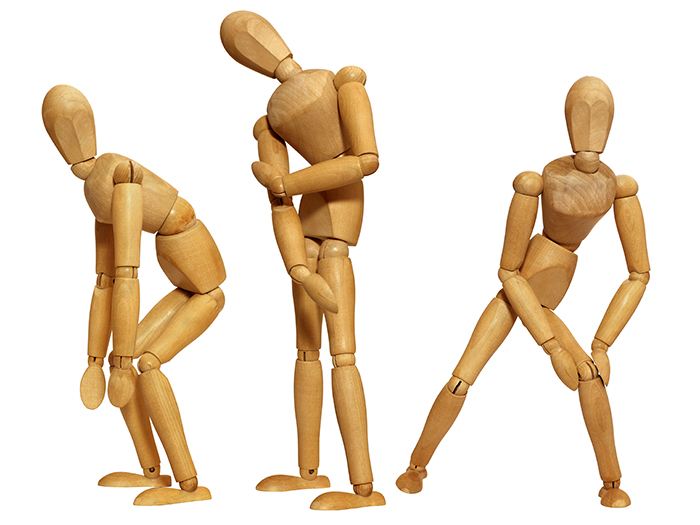6 Fast Fixes for Muscle Imbalances
It's common for one set of muscles to work harder than others. But that can lead to pain. Here's how to even things out.

You've heard of being left- or right-brained. Turns out most of us also have a dominant side of the body that leads the way when you're climbing stairs or lifting grocery bags out of the cart.
The difference may be pretty subtle, but if you’ve ever noticed one knee struggling to reach the same height as the other during a set of knee lifts in your SilverSneakers class, or one arm banging out biceps curls while the other seems to be on strike, that’s your cue that one side of your body or set of muscles is calling the shots.
Muscle imbalances are common and can strike at any age, but they are decidedly more noticeable-and problematic-the older you get. By now, your body has learned to accommodate old injuries and compensate for a lifetime of repetitive movements, such as crossing your legs the same way every day, favoring one side when you sleep, or always carrying your bag on a particular shoulder.
Making matters worse are two of the hallmarks of modern life: hunching over a computer, tablet, or smartphone, and sitting way too much, says Chad Walding, D.P.T., a physical therapist in Austin, Texas.
In people over age 65, Walding sees a number of common imbalances, including:
- Rounding in the spine, mid-back between the shoulder blades. This causes our neck and head to protrude, and our shoulders to round forward.
- Tightness in the front body, weakness in the back body. This happens because of that common rounded sitting position.
- Tight hip flexors. This is also caused by prolonged sitting. It can pull the lower back into a C-shaped curve, as well as weaken the glutes and core.
Is Your Body Balanced? Find Out Now
So you're a little out of balance-it can't be that big of a deal, right? Not so fast.
All of the issues described above can not only lead to decreased mobility and pain but also increased risk of injury, says Mark Milligan P.T., D.P.T., director of physical therapy at Vori Health, a virtual holistic health provider that incorporates physical therapy as part of an integrated approach to treating muscle and joint pain.
Weak muscles are more prone to tears and strains, while stronger muscles can suffer from overuse. And if your balance is affected, it can up your chances of taking a nasty spill that could land you in the hospital facing a lengthy rehab, says Walding.
Your instinct may be to reach for the pain relievers, or you may worry that you need surgery. In some cases, both may be warranted. But first things first: It's vital to understand and address the root cause of the pain.
Try this: Grab a chair, position it in front of a mirror, and do these checks.
Check #1: Look at Yourself from the Side
Turn your side toward a mirror, and stand up as tall as you can. Check your reflection. Your ears should be in line with shoulders, and shoulders in line with hips. What you may see if you have some imbalances: ears coming forward from the shoulders, or your head coming forward relative to shoulders.
Check #2: Watch Your Walk
Walk toward the mirror. If you notice your palms face backward, it's a sign that your shoulders remain in the standard hunched position for sitting at a desk, looking at a phone screen, or watching TV on the couch.
“Anytime you see ears in front of shoulders or palms facing backward, you’ll know you have some moderate to severe musculoskeletal imbalances,” Walding says.
The body adapts to this posture by creating imbalances. Some muscles get tighter, while others lengthen and grow weak. It can lead to structural issues in the spine, joints, and ligaments.
Check #3: Get In and Out of a Chair
With the chair facing the mirror, sit down and get up from it naturally. If you lean forward or need support, that's a sign that your body is out of alignment. Doing more exercises that focus on the leg and core muscles will help even things out.
Check #4: Do a Dress Rehearsal of Your Daily Routine
Go through all the little things you need to do to go about your day.
- Sit down and tie your shoelaces.
- Next, while still seated, place your left foot on top of your right knee — then try and repeat the move with your right foot.
- Reach back to tuck in your shirt.
- Scratch the middle of your back.
- Go through the motions of washing your hair.
If any of the above are difficult for you, says Milligan, that’s a sign of muscle weakness or imbalance.
“People that have muscle imbalances would see that activities that they could once do easily — or positions that they could once easily get into — are no longer achievable,” he says.
Take notes as you do these quick self-checks, and be sure to share the results with your health care provider and/or a physical therapist. These are valuable clues that will help inform any treatment plan they recommend for you.
6 Simple Ways to Fix Muscle Imbalances
Now, for some good news. It is possible to get your weaker muscles back up to speed. Here are five easy fixes that you can do anytime.
Como siempre, la clave es la seguridad. Los ejercicios aquí podrían ser distintos o más avanzados que los de que aplicará en una clase SilverSneakers. Si tiene alguna afección crónica, alguna lesión o problemas de equilibrio, consulte a su médico sobre cómo puede ejercitarse de manera segura.
Fix #1: Take a Walk
“Start walking consistently to get your blood flowing and get out of a stagnant seated position,” Walding recommends.
He suggests beginning with taking a walk in the morning and another in the afternoon. Start with five minutes and work your way up. As you walk, pay attention to straightening your spine, taking shorter strides, and keeping a brisk pace.
Every so often, check your shoulder position by deliberately turning your palms forward. This will help your shoulders go back and down for better posture.
Fix #2: Shrug Your Shoulders
This is a simple way to improve your upper-body posture. Squeeze your shoulders toward your ears for five seconds, pinch your shoulder blades behind you for five seconds, and then relax. Repeat two or three more times. Aim to do this twice a day. This will release tension in your shoulders, put them back in proper position, and decrease any pain.
Fix #3: Stretch Your Shoulders
While seated in a chair or on the couch, take your hands, interlock them behind your head, and point your elbows forward. Then gently lift them up toward the ceiling, looking up, and then lower back down. Repeat five times.
Suscríbase a nuestro boletín informativo
Es rápido y fácil: Usted podría estar entre las 13 millones de personas elegibles.
¿Ya es miembro? Haga clic para descubrir nuestros más de 15,000 centros participantes.
Síganos
Fix #4: Strengthen Your Glutes with the Bridge
Lying on a mat or the bed, place your feet flat on the ground with knees bent. Press your feet into the floor and squeeze your glutes to lift your hips off the floor. Pause, and return to the floor slowly. Repeat 10 to 20 times.
Want more options? Find your perfect version with these glute bridge variations.
Fix #5: Try a Hip Flexor Stretch
Lie down on your bed close to the side of the bed. Let your left leg hang off the side of the bed, and gently bring your right knee in toward your chest. Hold for 30 seconds and up to two minutes. Repeat on the other side, and do one to two sets.
Plus, check out these hip stretches.
Fix #6: Master the Squat
The squat exercise mimics a movement that all of us do several times a day, says Milligan. It's a functional exercise that you should work on daily.
Stand with your feet at a comfortable width and toes pointed forward. Place your hands on the back of a chair for support, if needed. Keeping your eyes forward, chest up, and heels planted, push your hips back to lower into a squat. Reach your arms straight out from your shoulders to help counterbalance. Once you squat as far as comfortable, push through your heels to return to standing.
Plus, check out these squat variations.
When to See the Doctor
You may find immediate relief with some of the fixes above. With continued practice, you'll likely notice increased strength, mobility, and flexibility.
That said, Milligan says it's important to let your health care provider know about the results of your quick self-checks. Also let them know how the fixes go, too.
“If your right leg feels great when you do the bridge, for example, but your left leg doesn’t really want to cooperate, that’s something you’d want to let your doctor and a physical therapist know about,” says Milligan.
Still experiencing pain or weakness that limits your ability to go about your daily life? Worried about your balance-or falling? Check in with your doctor, who can help you figure out if there's an underlying issue and the right solution.
¡Tome en línea sus clases favoritas de SilverSneakers!
Los miembros de SilverSneakers pueden acceder a clases de fitness y talleres de bienestar en vivo, a través de SilverSneakers EN VIVO. Vea la programación más reciente y RSVP clases aquí.
¿No es miembro? Si tiene un plan Medicare, puede que incluya SilverSneakers, sin costo adicional para usted. Verifique su elegibilidad al instante aquí.





